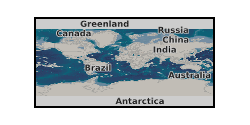Peat
Type of resources
Available actions
Topics
Keywords
Contact for the resource
Provided by
Years
Formats
Update frequencies
-

This dataset comprises raw carbon, oxygen and hydrogen stable isotope data on water (precipitation and terrestrial) and plant cellulose from Empodisma-dominated peatlands throughout New Zealand. This data has been published in two open access papers: Amesbury, M. J., Charman, D. J., Newnham, R. M., Loader, N. J., Goodrich, J. P., Royles, J., Campbell, D. I., Roland, T. P. and Gallego-Sala, A. V. 2015. Carbon stable isotopes as a palaeoclimate proxy in vascular plant dominated peatlands. Geochimica et Cosmochimica Acta 164, 161-174. Amesbury, M. J., Charman, D. J., Newnham, R. M., Loader, N. J., Goodrich, J. P., Royles, J., Campbell, D. I., Keller, E. D., Baisden, W. T., Roland, T. P. and Gallego-Sala, A. V. 2015. Can oxygen stable isotopes be used to track precipitation moisture source in vascular plant dominated peatlands? Earth and Planetary Science Letters 430, 149-159.
-

Peat properties data and age depth models for 102 peat cores extracted and analysed for the Increased Carbon Accumulation in Arctic Peatlands (ICAAP) project (Grant NE/S001166/1). Peat cores were extracted from 12 peatland sites from four regions of the Arctic: Svalbard, Norwegian and Finnish Lapland, Nunavut, Canada and Quebec, Canada Data originates from the analysis of Arctic peat cores for changes in rates of lateral expansion and vertical peat accumulation during recent centuries. Specifically, peat cores were analysed for moisture content (%), dry bulk density (g cm-3), C/N content (%), 210Pb activity levels (bq/kg), and 14C radiocarbon age (yr BP). Svalbard (78.09065°N 14.98407°E; 78.98595°N, 11.98246°E; 78.95872°N, 11.68331°E) Norwegian and Finnish Lapland (70.11876°N, 28.48351°E; 69.80659°N, 27.19732°E, 69.38787°N, 24.24123°E), Nunavut, Canada (72.655515°N, 78.061646°W; 72.694207°N, 77.864603°W; 73.13028°N, 80.022987°W) Quebec, Canada (62.165681°N, 75.915017°W; 62.123168°N, 75.769467°W; 62.157355°N, 75.607301°W)
 NERC Data Catalogue Service
NERC Data Catalogue Service